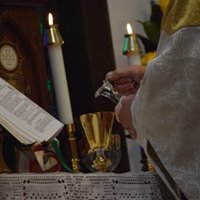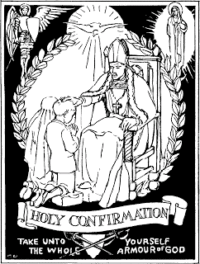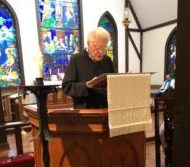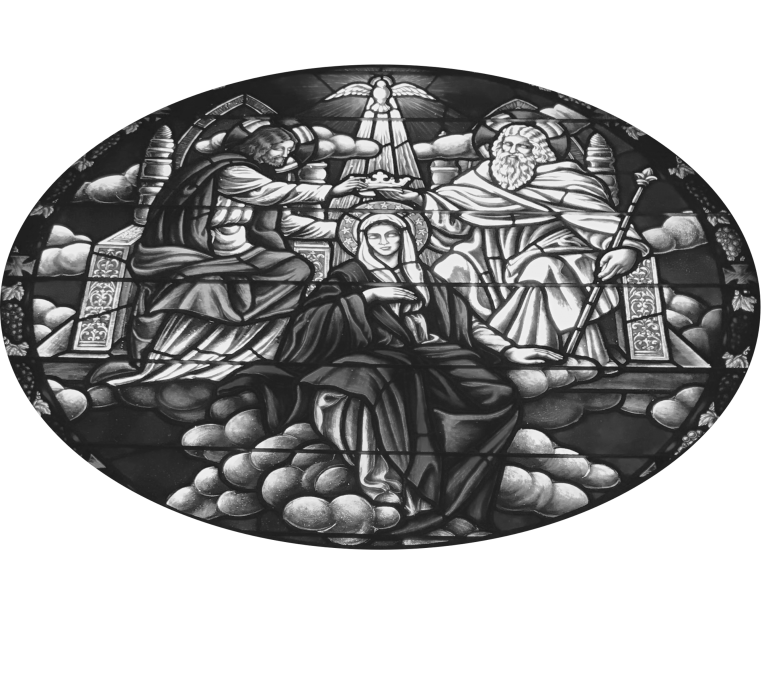Nature of Anglicanism – Sacraments
THE SACRAMENTAL LIFE: PART I
Introduction: Sacramental symbols draw on our salvation history and reflect the role of the Church as a Sacrament of God’s presence in the world.
God performs the Sacraments with ministers as God’s human agents. Sacrament comes from a Latin word (sacrare) meaning holy. Anglican definition of a Sacrament is “The outward and visible sign of an inward and spiritual grace given unto us; ordained by Christ himself (BCP p. 292.)”
The Sacraments of Baptism and Holy Eucharist are grounded in scripture and essential for all Christians.
Confirmation, marriage, ordination, penance, and unction are called sacramental rites and are not essential for all Christians, but impart strengthening grace for specific situations in life.
The actions of the Sacraments confer grace to live sacramentally in the world. Five things are required for a sacrament to be recognized or valid. (Note: see chart)
The Matter is the outward and visible sign of the sacrament.
The Form is the action required to perform the sacrament (basically the prayers and ritual used.)
The Intention is the result desired – the inward and spiritual grace of the sacrament.
The Subject is the person (persons) who is (are) to receive the sacrament.
The Minister is the person who is to celebrate or administer the sacrament. Some sacraments may be celebrated only by a bishop, others by priest, and still others by any baptized Christian.
Brief overview:
Baptism (BCP Page 273) The Matter is water and the Form is three fold name and pouring or water or immersion. The intention is to give remission of sins and a new life, the subject is anyone not already baptized, and the minister can be any Christian. Infants become members of Christ’s family through Baptism. Parents and godparents make the baptismal promises on behalf of a child being baptized and promise to support the child’s growth in faith. Baptism is performed only once for an individual. We live our Baptism by fulfilling the promises made.
Holy Eucharist (BCP Page 296) The Matter is the Bishop’s hand and the Form is receiving the gift of the Holy Ghost. The intention is to give the gift of the Holy Ghost for lay ministry, the Subject is any baptized Christian and Minister is a Bishop. Confirmation completes the baptism and conveys the sevenfold gift of the Holy Spirit. Confirmation implies a full knowledge of the importance of the Eucharist and the essentials of the Christian Faith. A person confirmed by a bishop within the Apostolic Succession from another branch of the Cathlic Church is received into the Anglican Faith by our Bishop.
The Eucharist is the regular duty of all Christians to receive frequently and was instituted at the Last Supper with His command to “This do as oft as ye shall eat/drink this in remembrance of me (I Cor 11:23-16.) The Matter is bread and wine and the Form are the words of the consecration together with the rest of the prayer. The Intention is to do what Christ did (and command us to do) at the Last Supper. The Subject is any baptized informed and confirmed Christian with the minister being a Bishop or Priest. The Holy Eucharist signifies the Body and Blood of Christ (The Real Presence), truly present in a way that we cannot explain. For Anglicans, the Holy Eucharist is not simply a memorial but a spiritual reliving of the one sacrifice of Christ on the cross. It is the spiritual food of the most precious Body and Blood of our Saviour, Jesus Christ. And incorporates us into the mystical Body of Christ. Through the Holy Eucharist, the Church is unified with Christ and becomes a sign to the world of Christ’s redeeming sacrifice.
Holy Orders is the sacrament of the ministry or ordination. The Matter is the Bishop’s hand and the Form is Receiving the gift of the Holy Ghost. The intention is to set a man apart for the work of the ordained ministry. The Subject is any baptized and confirmed male Christian and the Minister is a Bishop. Ordination may be done only once because it applies a change of character of the Subject through the action of the Holy Spirit.
Holy Matrimony utilizes the Matter of a Handclasp and its Form is of The Promise. The Intention is to be a faithful spouse. The Subjects are the baptized Christian Man and Woman and the Minister is the marrying couple. Matrimony is a permanent body between the couple and represents the relationship between Christ and His Church; meaning that the husband is supposed to act toward his wife as Jesus acts towards the Church, and the wife behaving toward her husband as the Church acts towards Christ. This relationship allows for happiness and fulfillment together.
Penance (confession) has as the Matter the penance itself and the Form “I absolve thee in the Name of.” The Intention is to declare forgiveness of sin. The Subject is any Baptized Christin and the Minister is Bishop or Priest. The penance assigned is commensurate with the sin ranging from prayers for help in personal improvement to making restitution (even turning oneself in to the authorities for a felony. The confessor must never divulge a confession to a third party and cannot bring it up again to the Penitent unless brought up by the penitent under the seal of another confession.
Unction has as the Matter Oil Blessed by the Bishop in the Form of “I anoint thee in the name of.” The Intention is to give health of body and spirit. The Subject may be any baptized Christian and the Minister is a Bishop or Priest. There is none other Name under heaven given to man, in whom, and through whom, thou mayest receive health and salvation, but only the Name of our Lord Jesus Christ (BCP page 314.)
| Sacrament | Matter | Form | Intention | Subject | Minister |
| Baptism | Water | 3-fold name & pouring of water or immersion | To give remission os fins and new life | Anyone not already baptized | Any Christian |
| Confirmation | Bishop’s hand | Receive the gift of the Holy Ghost | To give the gift of the Holy Ghost for lay ministry | Any Baptized Christian | Bishop |
| Order | Bishop’s hand | Receive the gift of the Holy Ghost | To set a man apart for the work of the ordained ministry | Any Baptized and Confirmed male Christian | Bishop |
| Eucharist | Bread and wine | The words of consecration toether with the rest of the prayer | To do what Christ did at the Last Supper | Any baptized, informed and confirmed Christian | Bishop or Priest |
| Matrimony | Handclasp | The Promise | To be faithful to one spouse | Any baptized Christian man and woman | The Marrying couple |
| Penance | The Penance | I absolve thee in the Name of … | To declare the forgiveness of sin | Any baptized Christian | Bishop or Priest |
| Unction | Oil blessed by bishop | I anoint thee in the name of … | To give health of body and soul | Any baptized Christian | Bishop or Priest |
Explanation:
Symbols are integral to our understanding of the sacraments of the Church. Sacramental symbols date from the salvation history of Israel, when covenants between God and his chosen people were marked with physical signs. A rainbow marked God’s promise to Noah; the tablets of stone and the Ark of the
Covenant were signs of God’s presence with Moses and the wandering tribes. Even now, the foods consumed at modern Passover meals are symbols of God’s saving acts of deliverance from bondage in Egypt.
The early Christian Church inherited, continued, and deepened this sacramental understanding of our relationship with God. The Church itself, the Christian community, is an outward sign, a sacrament of God’s presence among us. The symbols we use in our sacramental rituals are reminders of our salvation history. They also point forward to the fulfillment of God’s eternal promises.
Early in church history, St. Augustine formulated the understanding that God performs the sacraments; the minister is merely the human agent. Thus the validity of the sacrament is not dependent upon the virtue or spiritual merit of the minister performing the physical action. By the time of St. Thomas Aquinas there were seven sacraments recognized by the Roman Catholic Church: baptism, confirmation, the Eucharist, ordination, marriage, penance, and unction.
Anglicans regard Holy Baptism and Holy Eucharist as grounded in scripture and essential for all Christians. The other five, often called Sacramental Rites, are not necessary for all Christians and have a more ambiguous scriptural warrant. Nevertheless, Anglicans have no trouble referring to all seven as sacraments. Our discussion on the sacraments will therefore be divided into two sessions, one for Holy Baptism and Holy Eucharist, the other for the Sacramental Rites.
The understanding of sacramental efficacy is another point of striking difference between Protestants and Catholics. Protestants from Luther and Calvin onwards have defined the Church around the proclamation of the Word, understood as the preaching of the Word. The Catholic tradition has understood the Church much more as the sacrament of Christ and therefore as the community practicing the sacraments. Luther held that the sacraments impart no grace that is not also found in the preaching of the Word. Calvin understood them as secondary to the Word, merely confirming God’s promises given in the Word. The Roman Church, on the other hand, developed and maintains an understanding of all seven sacraments as objectively efficacious; that is to say, God uses them to confer the grace signified by the outward symbol. Taking Holy Baptism as an example, God uses the outward sign of water to confer the inward grace of new birth in Christ and forgiveness of sin.
Anglicanism seeks a balance between word and sacraments. Historically it has veered from emphasis on one to emphasis on the other. The Oxford movement of the mid-19th century played a vital role in restoring the centrality of the sacraments in the Anglican Churches. Today Anglicanism attempts to hold together people who would stress one or the other. Word represents Christ in proclamation and in moral commitment; Sacrament represents Christ in communal action and through material objects. The word convinces us through our faculties of intellect and reason and may persuade us to acts of love and mercy. The sacraments persuade through motion and our five senses; they create our sense of belonging to a community reaching back in time to Christ and the apostles, and even to Abraham, and forward to the communion of saints.
In our Communion service, there are two times when the priest elevates something: the reading of the gospel and the consecration of the bread and wine: word and sacrament are lifted up. See the story of Philip and the Ethiopian eunuch (Acts 8:34-38): the eunuch hears the word, but then consents to be baptized. We need both; it is not enough to preach or to be convinced so that we may attain salvation; God wants a covenanted community in a sacramental world of rainbows, handshakes, rings given and exchanged, bread and wine blessed and broken and shared. Through the sacraments, God tells us that the world is more than it appears to be, that there is deeper meaning in our surroundings, in our relationships and in our lives.
The action of the sacraments is not limited to the space in which we celebrate them. God bestows upon us the grace to carry these actions out into the world. In the Holy Eucharist, for example, we recall, relive, and continue the Incarnation, carrying Christ out into the world with us. In the Rite of Reconciliation, we are reconciled in our own relationship to God but we are also renewed as reconciliation people, bringing that spirit into our communities.
In Holy Baptism, we see sacramental action in its most easily understood form. We can see, feel, and hear the water but we cannot see God’s grace; we cannot see repentance; we cannot see the community’s acceptance; we cannot see faith. Water symbolizes cleansing, drowning, and rebirth, dissolving (forgiving our sins), and the down-pouring of God’s grace. Water is common but essential for life, a precious commodity in the often desert locations where the Church was born. Through the symbol of water, the Church looks back in salvation history to Noah and the cleansing flood, to Israel’s passage through the Red Sea, and to the baptism of Jesus by John.
Even as infants, we are baptized by a community and are accepted into that community. Just as Jesus welcomed little children to come to him (Mark 10:14), the Christian family welcomes even the youngest into our household. Because infants and small children are unable to make a profession of faith or to affirm the baptismal promises, parents and godparents or sponsors make these affirmations for them and promise to do all they can to nurture and encourage the child’s growth in faith. At a later time, the young adult will be able to claim this faith and renew these promises (see Confirmation).
Baptism by water and in the name of the Holy Spirit is full initiation into the Christian community and is an unrepeatable sacrament. Although we are all sinners, even after baptism, there are opportunities for forgiveness and renewal in other rites of the Church. We have the opportunity to renew our baptismal promises whenever someone is baptized and in the Confirmation liturgy. At each General Confession and in the Rite of Reconciliation (Confession), we receive forgiveness of sin. In Confirmation, there is even an opportunity for a formal reaffirmation of faith with laying on of hands by the bishop.
Because each baptism is such an important part of the life of the Church family, baptisms properly take place during the major Sunday services rather than privately. The most appropriate occasions for Baptism are the feasts of the Baptism of Our Lord, the Easter Vigil, Pentecost, and All Saints or whenever a bishop is present. Through our baptism we are deputized to continue the work of Christ.
THE HOLY EUCHARIST (Mark 14:22-24; 1 Cor.11:23-26): The Last Supper:
The Holy Eucharist is a meal for the whole family of Christ, taken at the Lord’s Table. Like Baptism, it is a sacrament created by Christ. As such, it looks backward to the Passover meal, eaten by the people of Israel as they were preparing for their liberation from slavery in Egypt. It looks backward to the Last Supper, in which Jesus took, blessed, broke, and gave bread to his disciples in preparation for his sacrifice on the cross when he liberated us from sin and death. The words of consecration are taken directly from Holy Scripture, in which Jesus commands us to “do this for the remembrance of me.” Finally, it looks forward to the heavenly banquet.
We understand this remembrance as a re-living rather than as a commemoration. Christ’s sacrifice on the cross took place in historical time but exists eternally. His sacrifice is not repeated but is celebrated in the Holy Eucharist in our own time. Christ is not sacrificed anew but, through the power of the Holy Spirit, the Church is present at his one sacrifice in a spiritual sense. The word Eucharist comes from the Greek for thanksgiving. In Holy Eucharist we give thanks for Christ’s eternal sacrifice for us and we experience it anew.
Christ is truly present in the Holy Eucharist but the precise mechanism is a mystery. We call this doctrine the “Real Presence.” Here again, the Anglican tradition stands between the Protestant view, in which communion is often seen as a memorial celebration, and the Roman Catholic view of transubstantiation in which the elements are believed to be materially transformed into the Body and Blood of Christ. In the Real Presence, we believe Christ is present in the consecrated elements in a special but mysterious way. For this reason, we treat the consecrated bread and wine reverently, by consuming them immediately, or reserving them for later consumption.
Anglican priests do not celebrate Holy Eucharist alone—at least one communicant must be present with the priest for Holy Communion. In the Holy Eucharist, we not only remember the Incarnation and our Lord’s sacrifice on the cross, but Jesus Christ becomes truly present among us. We are united with him individually and as a Church; we continue the Incarnation as the Body of Christ. We are then charged to carry the Incarnation out into the world, to become the Real Presence of Christ in our relationships to God and our neighbor.
Summary:
As the Catechism points out, these other Sacramental Rites are means of grace, just as Holy Baptism and Holy Eucharist are, but unlike the two great sacraments, they are not necessary for all persons. In the Sacramental Rites God through His Church addresses the needs of the people in different life circumstances and passages.
The Anglican Church welcomes even infants into the household of God by Holy Baptism. Because they are not yet able to enter into the Baptismal Covenant for themselves at that age, their parents and godparents make the promises and affirmation of faith on their behalf. Confirmation evolved allowing those baptized at an early age to make a mature profession of faith and commitment to Christ. In this sacrament, we receive the laying on of hands by a bishop, linking us to the apostles in an unbroken chain. We receive strength from the Holy Spirit to live the Christian life according to our baptismal promises, reiterated in the confirmation liturgy.
Prerequisites for confirmation are Holy Baptism, instruction in the faith, and a mature intention to make a public profession of faith and commitment to Christian responsibility. Young people who were baptized as infants are typically confirmed when maturity is obtained, and this in times past was between the ages of 12 and 16. The Anglican Tradition recommends that confirmation be deferred until greater psychological maturity and independence for this important step. Baptism incorporates you into the body of Christ’s Church, and Confirmation prepares you to take Christ out into the world to others.
Part II
Order: The Church has recognized three distinct orders of ordained ministry since the time of the apostles. Bishops, priests, and deacons each have distinct leadership functions. Through a process of mutual discernment, the Church recognizes those who are called by God to ordained ministry and admits them to Holy Orders through prayer and laying on of hands by a bishop or bishops duly qualified to ordain and consecrate. The manner of ordination in the Anglican Church is consistent with the customs of the early Church in order to affirm the continuity of these sacred orders in historical time.
THE ORDINATION OF A BISHOP
Bishops are ordained whenever possible on Sundays, feasts of Our Lord, or of the apostles or evangelists. The Presiding Bishop or designee presides and is chief consecrator, accompanied by at least two other bishops. Consecration by at least three bishops both symbolizes and assures that new bishops are part of a community of ordained overseers and chief pastors stretching back in history to the time of the apostles and linking around the globe with other bishops in the one, holy, catholic Church of today.
THE ORDINATION OF A PRIEST
A priest is ordained by a duly qualified bishop in the presence of at least two other priests. Through prayer and the laying on of hands by the bishop and other priests, God confers the grace and power to equip the new priest for his duties.
THE ORDINATION OF A DEACON
Candidates for priesthood, or those desiring only the role of Deacon – Perpetual Deacons, are first ordained as deacons, an order of ministry first mentioned in the Acts of the Apostles as those chosen to serve the people of God and assure just treatment of the helpless while the apostles preached and taught (Acts 6:1-6). They were ordained by laying on of hands. Deacons who will later be ordained as priests are called “transitional deacons.” The diaconate is a special ministry of servant hood.
SUMMARY Bishop: A Bishop serves the ministry of OVERSIGHT, coordinating and propagating the work of the Church. A Priest serves the ministry, leading a community in its varied circumstances to do the work of the Church, feeding and forming the community as it does so. Deacon: A Deacon serves the ministry of SERVICE, engaging the Church and its local communities in meeting the needs of those both inside and outside its fellowship.
HOLY MATRIMONY
The sacrament of matrimony is actually performed by the two persons being married, not by the celebrant. The celebrant pronounces the blessing of the marriage. It is a “solemn and public covenant between a man and a woman in the presence of God.”
Assurance must be made that both parties have the right to contract a marriage according to the laws of the State; that both parties understand that Holy Matrimony is a physical and spiritual union of a man and a woman, entered into within the community of faith, by mutual consent of heart, mind, and will, and with intent that it be lifelong; that both parties freely and knowingly consent to such marriage, without fraud, coercion, mistake as to identity of a partner, or mental reservation; both partites have received Holy Baptism; that both parties have been instructed as to the nature, meaning, and purpose of Holy Matrimony by the Member of the Clergy and received such instruction. Clergy typically prepare a couple for marriage during several joint sessions during the weeks or months immediately preceding the wedding.
The liturgy of Holy Matrimony takes place in the context of the Liturgy of the Word and may be followed by Holy Communion. After the exhortation, the man and woman each give their consent to the marriage and the witnesses, including the congregation, promise to uphold the couple in their marriage. The actual marriage, or exchange of vows, comes after the scripture readings. The couple join hands as they exchange their vows to love, sustain, and support one another in success and in adversity until death. These words and the joining of hands are the outward sign of the grace given in marriage, the grace to live up to those vows. Although rings are commonly blessed and exchanged, they are not essential and are not the sacramental sign.
We pray that the married couple may be a sign of Christ’s love for the world, in other words, that their relationship itself be a sacrament, a sign of unity, forgiveness, and joy, and that their affection would overflow into their community. The marriage concludes with a priestly blessing, asking God’s grace that they may live into their marriage covenant faithfully.
RECONCILIATION OF A PENITENT
In the Anglican Church, private confession is available but not required. The offices of Morning and Evening Prayer and the liturgies of Holy Eucharist contain general confessions and absolutions deemed efficacious and sufficient whenever we seek forgiveness from God with truly penitent hearts.
There are two forms of service for private confession, however, and they may be used whenever a penitent wishes. Private confession is frequently sought and offered during a time of crisis or great change, during a serious illness, during Lent, or when the penitent is greatly troubled and in need of pastoral care. The Rite of Reconciliation is by no means limited to these times, however.
The confessor may spend some time in pastoral conversation with the penitent in preparation for the Rite. A preparation exercise for preparing for Confession may be helpful. After the penitent confesses all serious sin, the confessor may offer “counsel, direction, and comfort” as well as assigning some prayer or action to be performed as a sign of contrition and thanksgiving. Only a bishop or a priest may then pronounce absolution in the service. The contents of the confession are a matter of absolute secrecy for the confessor (“the seal of the confessional”).
Each Christian has a ministry of reconciliation to the world, exercised through our care for others, our willingness to give and receive forgiveness to and from our neighbors, and our work for peace and justice. We live sacramentally when we embody Christ’s ministry of reconciliation in our daily relationships.
UNCTION
The anointing of the sick with prayer for healing and laying on of hands is recommended in the Letter of James and has been practiced by the Church since earliest times. It became associated with the time of death, however, and was at one time called “Extreme Unction.” Now it is recognized that prayers and anointing for healing of body, mind, and spirit are appropriate at any time
We think of doctors, nurses, counselors, and other kinds of caregivers as having healing ministries and indeed, some Christians have specific and powerful healing gifts from the Holy Spirit. All Christians, however, are called to a sacramental life of healing, living in our broken world as a sign of Christ’s healing ministry by visiting and caring for the sick, advocating for the disenfranchised, honoring our own physical, mental, and spiritual well-being, and conducting our lives with reverence for the gift of creation.
“There is none other Name under heaven given to man, in whom, and through whom, thou mayest receive health and salvation, but on the Name of our Lord Jesus Christ. Amen” BCP p. 314
SUMMARY – What is Sacramental living?
Each of the seven sacraments addresses the spiritual needs of Christians as individuals, but they also have implications for the way we bring the Kingdom of God into reality in the world. By fully living out these sacraments—keeping our baptismal covenant, embodying Christ, being witnesses, healers, and reconcilers— we ourselves become sacraments. As sacramental Christians we are outward, visible signs of God’s grace, grace that is ever-present and abundantly available whenever we make ourselves open to it in faith.






